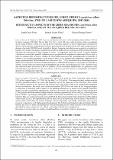Por favor, use este identificador para citar o enlazar este ítem:
https://hdl.handle.net/20.500.12958/3454| Título : | Aspectos reproductivos del erizo verde Loxechinus albus (Molina, 1782) de la Región Arequipa, 2017-2018. |
| Otros títulos : | Reproductive aspects of the green sea urchin Loxechinus albus (Molina, 1782) of the Arequipa Region. 2017-2018. |
| Autor : | Incio Pérez, Angela Lucero Pérez, Stevens Barriga Rivera, Edward |
| Palabras clave : | Loxechinus albus;Erizo;Reproducción;Perú - Arequipa |
| Fecha de publicación : | 2020 |
| Editorial : | Instituto del Mar del Perú |
| Citación : | Bol Inst Mar Perú. 35(1) 2020, p. 60-68 |
| Citación : | Boletín IMARPE 35(1), 2020; |
| Resumen : | El erizo verde Loxechinus albus es endémico de las costas de Perú y Chile, y es uno de los invertebrados marinos de mayor importancia comercial. El objetivo del estudio fue determinar la condición gonadal mensual, proporción sexual e índices reproductivos durante el periodo 2017-2018 en el litoral de la Región Arequipa, para determinar su patrón reproductivo, basados en el análisis histológico, mediante el método de infiltración en parafina, de 1092 muestras de bancos naturales de la provincia de Islay durante 14 meses. La proporción sexual fue de 0,8: 1 machos respecto a hembras. La condición gonadal evidenció mayor proporción de organismos madurantes (II) en mayo y julio, de maduros (III) de julio a octubre, de desovantes/expulsantes (IV) principalmente en setiembre y octubre; y en recuperación/reposo (V) de marzo a mayo, no se identificaron organismos virginales (I). El índice gonadosomático (IGS) exhibió el valor más alto en julio (12,4%). Los índices de actividad reproductiva (IAR) y desovante (IAD) mostraron tendencia similar, el IAR de las hembras tuvo valores altos en setiembre y octubre, cuando hubo mayor presencia de ejemplares con elevado desarrollo gonadal. El IAD mostró su más alto valor en octubre, el cual fue de 48% en hembras y 71,4% en machos, identificando a la primavera como principal época reproductiva, lo que coincide con lo descrito por otros autores y presentando una relación directa con la temperatura más baja. ABSTRACT: This research aimed to determine the monthly gonadal condition, sex ratio, and breeding rates of the green sea urchin Loxechinus albus, which is an endemic species of the Peruvian and Chilean coasts and is one of the most commercially important marine invertebrates. The study was carried out between 2017-2018 in the coast of the Arequipa Region to determine its breeding pattern, based on the histological analysis, by means of the paraffin infiltration method, of 1092 samples from natural banks in the Islay province over 14 months. The sex ratio was 0.8 M: 1 F. The gonadal condition showed a higher ratio of maturing organisms (II) in May and July, mature (III) from July to October, spawning/expelling (IV) mainly in September and October, and in recovery/rest (V) from March to May, no virgin individuals were identified (I). The gonadosomatic index (GSI) showed the highest value in July (12.4%). The reproductive activity index (RAI) and spawning activity index (SAI) showed a similar pattern; the RAI of the females had high values in September and October when there was a greater presence of specimens with high gonadal development. The SAI showed its highest value in October (48% in females and 71.4% in males) and spring was the main breeding season, which coincides with what has been described by other authors and has a direct relationship with the lower temperature. |
| URI : | https://hdl.handle.net/20.500.12958/3454 |
| ISBN : | 04587766 |
| Aparece en las colecciones: | Boletín 35(1), 2020 |
Ficheros en este ítem:
| Fichero | Descripción | Tamaño | Formato | |
|---|---|---|---|---|
| Boletin 35-1 articulo6.pdf | 678,13 kB | Adobe PDF |  Visualizar/Abrir |
Este ítem está sujeto a una licencia Creative Commons Licencia Creative Commons

